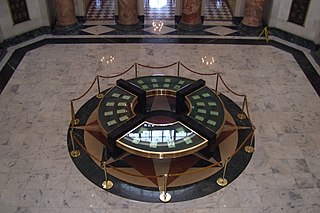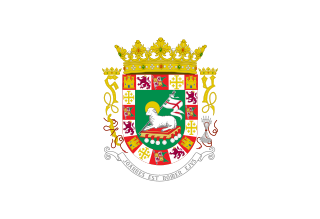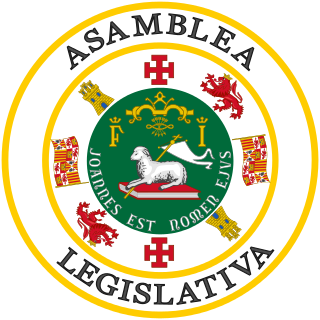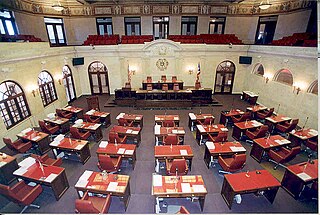Legislatures
| History of Puerto Rico |
|---|
The following is a list of terms of the Legislative Assembly of Puerto Rico, the territorial legislature of the Commonwealth of Puerto Rico.
| History of Puerto Rico |
|---|

The government of the Commonwealth of Puerto Rico is a republican form of government with separation of powers, subject to the jurisdiction and sovereignty of the United States. Article I of the Constitution of Puerto Rico defines the government and its political power and authority. The powers of the government of Puerto Rico are all delegated by the United States Congress and lack full protection under the U.S. Constitution. Because of this, the head of state of Puerto Rico is the President of the United States.

The Constitution of the Commonwealth of Puerto Rico is the controlling government document of Puerto Rico. It is composed of nine articles detailing the structure of the government as well as the function of several of its institutions. The document also contains an extensive and specific bill of rights. It was ratified by Puerto Rico's electorate in a referendum on March 3, 1952, and on July 25, 1952, Governor Luis Muñoz Marín proclaimed that the constitution was in effect. July 25 is known as Constitution Day.

The governor of Puerto Rico is the head of government of the Commonwealth of Puerto Rico, and commander-in-chief of the Puerto Rico National Guard.

The Senate of Puerto Rico is the upper house of the Legislative Assembly of Puerto Rico, the territorial legislature of Puerto Rico. The Senate, together with the House of Representatives of Puerto Rico, control the legislative branch of the government of Puerto Rico.

The House of Representatives of Puerto Rico is the lower house of the Legislative Assembly of Puerto Rico, the bicameral territorial legislature of Puerto Rico. The House, together with the Senate, control the legislative branch of the government of Puerto Rico.

The Legislative Assembly of Puerto Rico is the territorial legislature of the Commonwealth of Puerto Rico, responsible for the legislative branch of the government of Puerto Rico. The Assembly is a bicameral legislature consisting of an upper house, the Senate normally composed of 27 senators, and the lower house, the House of Representatives normally consisting of 51 representatives. Eleven members of each house are elected at-large rather than from a specific legislative district with all members being elected for a four-year term without term limits.

Elections in Puerto Rico are guaranteed by Article Six of the Constitution of Puerto Rico and the Electoral Code of Puerto Rico for the 21st Century Act. All processes are overseen and managed in whole by the Puerto Rico State Elections Commission; an autonomous agency of the executive branch of the government of Puerto Rico.
The 15th Legislative Assembly of Puerto Rico met from January 2, 2005, to January 1, 2009. All members of the House of Representatives and the Senate were elected in the General Elections of 2004. The House and the Senate both had a majority of members from the New Progressive Party. It was the second time in Puerto Rican history in which the majority of the Assembly was from a different party than of the Governor of Puerto Rico.

The Capitol of Puerto Rico, also known as Casa de las Leyes(House of Laws), and most commonly referred to as El Capitolio(The Capitol), is the seat of the Legislative Assembly, or the bicameral legislature, composed of the Senate and House of Representatives, responsible for the legislative branch of the government of Puerto Rico. Located on San Juan Islet immediately outside the Walls of Old San Juan, the oceanfront, neoclassical Beaux-Arts-style, entirely white marble-covered edifice was constructed between 1921 and 1929 to resemble the ancient Roman Pantheon in Rome, using as inspiration the Low Memorial Library in New York City. It was added to the National Register of Historic Places in 1977.
The Office of Legislative Services of Puerto Rico was created on January 27, 1954 to provide research, translation, library and legislative drafting services to all members of the Puerto Rico Legislative Assembly. Its duties are similar to those of the Congressional Research Service.

The president of the Senate of Puerto Rico is the highest-ranking officer and the presiding officer of the Senate of Puerto Rico. The president has voting powers as it is elected amongst the own members of the Senate as established by Article III of the Constitution of Puerto Rico. The Constitution, however, does not establish its functions and since the Senate is the only body authorized by the Constitution to regulate its own internal affairs, the functions of the president vary from session to session—save being called "President" as the Constitution establishes. The president is typically elected during the Senate's inaugural session.

The legal system of Puerto Rico is a mix of the civil law and the common law systems.

The Puerto Rico Public–Private Partnerships Authority (P3A) is a government-owned corporation of Puerto Rico created in order to regulate public–private partnerships (PPP) in Puerto Rico. It is a PPP unit whose responsibilities include promotion and assessment of public-private partnerships, as well as consultancy on PPP projects. Its organic law was enacted by the 15th Legislative Assembly and signed into law by Governor Luis Fortuño.

The Bar Association of Puerto Rico (BAPR) or Colegio de Abogados de Puerto Rico (CAPR) is the bar association of Puerto Rico. It is the oldest professional association in Puerto Rico, and among the oldest bar associations in the world.

The 17th Legislative Assembly of Puerto Rico was the 17th session of the Puerto Rican legislature that met from January 14, 2013 until January 1, 2017. All members of the House of Representatives and the Senate were elected in the General Elections of 2012. The House and the Senate both had a majority of members from the Popular Democratic Party (PPD).

The executive branch of the government of Puerto Rico is responsible for executing the laws of Puerto Rico, as well as causing them to be executed. Article IV of the Constitution of Puerto Rico vests the executive power on the Governor—who by its nature forms the executive branch.
The secretary of family affairs of Puerto Rico leads the Department of Family Affairs of Puerto Rico and all efforts related to the sociology of the family and social work in Puerto Rico.
Ramón Luis Cruz Burgos is a Puerto Rican politician affiliated with the Popular Democratic Party (PPD). Cruz Burgos studied in Manuel Ortiz Elementary School and attended Luis Muñoz-Marín High School in Yabucoa, Puerto Rico. He completed a Bachelor's Degree in Physics Applied to Electronics from the University of Puerto Rico at Humacao. He represented Puerto Rico in several national competitions at NASA, including three times in the Great Moonbuggy Race.
Events in the year 1943 in Puerto Rico.

The 19th Legislative Assembly of Puerto Rico will meet from January 2, 2021, to January 1, 2025. Members of the 31st House of Representatives of Puerto Rico were elected in the 2020 House of Representatives election, while members of the 27th Senate of Puerto Rico were elected the same day in the Senate election. The Popular Democratic Party does not have an outright majority in the Senate, but controls the chamber. While the PPD had a simple majority of representatives in the 31st House of Representatives from 2021 to 2022, this has ceased to be the case since 4 May 2022.